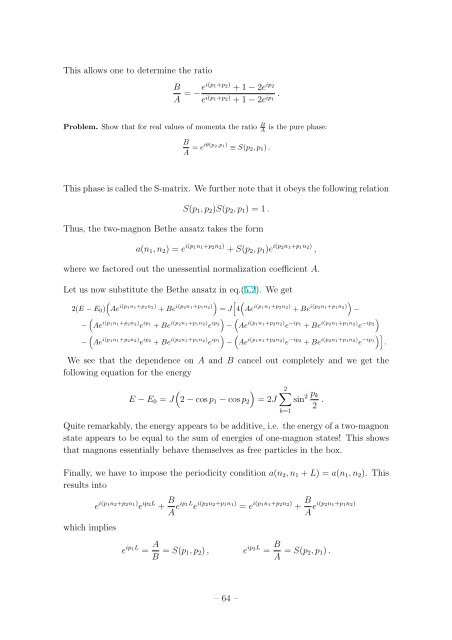Student Seminar: Classical and Quantum Integrable Systems
Student Seminar: Classical and Quantum Integrable Systems
Student Seminar: Classical and Quantum Integrable Systems
You also want an ePaper? Increase the reach of your titles
YUMPU automatically turns print PDFs into web optimized ePapers that Google loves.
This allows one to determine the ratio<br />
B<br />
A = −ei(p 1+p 2 ) + 1 − 2e ip 2<br />
e i(p 1+p 2) + 1 − 2e ip 1 .<br />
Problem. Show that for real values of momenta the ratio B A<br />
is the pure phase:<br />
B<br />
A = eiθ(p 2,p 1 ) ≡ S(p 2 , p 1 ) .<br />
This phase is called the S-matrix. We further note that it obeys the following relation<br />
S(p 1 , p 2 )S(p 2 , p 1 ) = 1 .<br />
Thus, the two-magnon Bethe ansatz takes the form<br />
a(n 1 , n 2 ) = e i(p 1n 1 +p 2 n 2 ) + S(p 2 , p 1 )e i(p 2n 1 +p 1 n 2 ) ,<br />
where we factored out the unessential normalization coefficient A.<br />
Let us now substitute the Bethe ansatz in eq.(5.2). We get<br />
(<br />
) [ (<br />
)<br />
2(E − E 0 ) Ae i(p 1n 1 +p 2 n 2 ) + Be i(p 2n 1 +p 1 n 2 )<br />
= J 4 Ae i(p 1n 1 +p 2 n 2 ) + Be i(p 2n 1 +p 1 n 2 )<br />
−<br />
)<br />
)<br />
−<br />
(Ae i(p1n1+p2n2) e ip1 + Be i(p2n1+p1n2) e ip2 −<br />
(Ae i(p1n1+p2n2) e −ip1 + Be i(p2n1+p1n2) e −ip2<br />
)<br />
)]<br />
−<br />
(Ae i(p1n1+p2n2) e ip2 + Be i(p2n1+p1n2) e ip1 −<br />
(Ae i(p1n1+p2n2) e −ip2 + Be i(p2n1+p1n2) e −ip1 .<br />
We see that the dependence on A <strong>and</strong> B cancel out completely <strong>and</strong> we get the<br />
following equation for the energy<br />
)<br />
E − E 0 = J<br />
(2 − cos p 1 − cos p 2 = 2J<br />
2∑<br />
k=1<br />
sin 2 p k<br />
2 .<br />
Quite remarkably, the energy appears to be additive, i.e. the energy of a two-magnon<br />
state appears to be equal to the sum of energies of one-magnon states! This shows<br />
that magnons essentially behave themselves as free particles in the box.<br />
Finally, we have to impose the periodicity condition a(n 2 , n 1 + L) = a(n 1 , n 2 ). This<br />
results into<br />
which implies<br />
e i(p 1n 2 +p 2 n 1 ) e ip 2L + B A eip 1L e i(p 2n 2 +p 1 n 1 ) = e i(p 1n 1 +p 2 n 2 ) + B A ei(p 2n 1 +p 1 n 2 )<br />
e ip 1L = A B = S(p 1, p 2 ) , e ip 2L = B A = S(p 2, p 1 ) .<br />
– 64 –

















